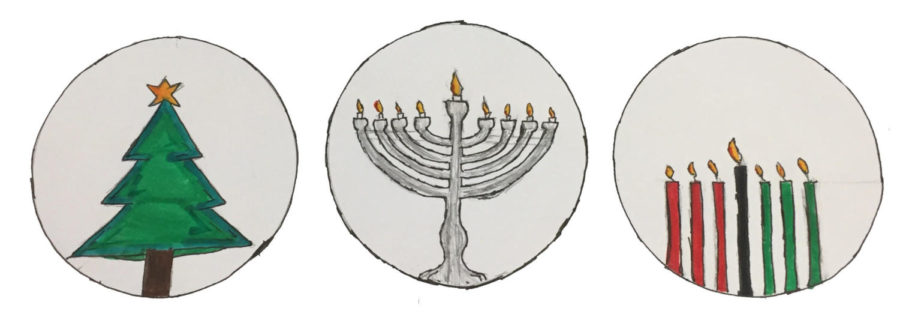Three Traditions Make December Special
The air is humming with holiday cheer and lights dazzle around porches and trees, illuminating the streets of Westport during dark December days. The holidays occurring are enough to brighten spirits and allow a joyous blanket to settle.
This month is home to several holidays, but three in particular stand out in this country: Christmas, Hanukkah and Kwanzaa. Each of them holds their own histories, traditions and commemorations; many students at Bedford celebrate at least one of them, if not two.
Christmas, observed on December 25 of every year, is celebrated by Christians who make up the majority of religious people in the United States. The festival commemorates the birth of who Christians believe to be the son of God, Jesus Christ.
Red is a frequently used color at this time, representing the holly berries said to symbolize the blood of Jesus on the cross. The exchanging of gifts to friends and family is also a hallmark of Christmas; in 2015, the average American spent $882 on presents, according to “Investopedia.”
Many students at Bedford thoroughly enjoy this shimmering holiday. Frankie O’Brien, a sixth grader, said, “Usually, every year we do a Secret Santa and put up a Christmas tree. It’s a time for family and I always really like it.”
Another prevalent holiday in Westport is Hanukkah, which typically falls sometime in December. In addition to lasting for eight days, its time differs each year because of its placing on the Hebrew calendar. While it is relatively minor to the Jewish people who celebrate it, it’s grown in recognition probably due to its overlapping with Christmas.
Hanukkah, the word meaning “dedication” in Hebrew, commemorates when the Seleucids (Syrian-Greeks) attempted to force the Israeli people to adopt Greek culture and beliefs instead of their own. A small group of Jews, however, managed to reclaim the Holy Land in Jerusalem. When they arrived to light the Temple Menorah, only a day’s worth of oil was found. They still proceeded to light the menorah and, miraculously, it lasted for eight days – hence the span of the holiday. A significant symbol is the menorah; a nine-branched candelabrum where a candle is lit each evening of the holiday.
Numerous students at Bedford celebrate it. “We normally have school during Hanukkah unless it happens really late, so we do all the celebrations in the evening,” said Sam Paris, a seventh grader. She went through the typical Hanukkah routine, telling that her family first lights one candle on the menorah at around sunset each day, saying prayers for the family as they do so. Sam then continued, “At least once, my mom hosts a Hanukkah dinner, where a lot of my relatives come over. My mom made a little booklet for a ‘service’ beforehand, so we go through it, with everyone reading at least one part.”
She briefed on the substantial meal each night, which is partly composed of latkes and applesauce, along with explaining that her family will play games such as spin the dreidel. “Right before we go to bed, we each get to open one or two presents. Then finish off the night by calling the people who gave us presents,” she said.
Kwanzaa, which is celebrated this year Dec. 26 to Jan. 1, is a more recent holiday combining several traditional African harvest celebrations. It was created in 1966 by Dr. Maulana Karenga to bring the African American community closer together after a neighborhood riot and help them connect with their heritage and culture. Feasts take place where customary foods are eaten such as kozi, an appetizer made from black-eyed peas, and okra and greens, a traditional side dish. Gifts are also exchanged.
A well-known symbol is the seven candles, showing a single black candle to represent the people, three red ones depicting the struggle, and three green ones to portray the future and hope transpiring from those struggles.
Some students celebrate more than one holiday for a variety of reasons. Henry Levin, also in seventh grade, is an example of this. “I’m Jewish, but my parents think Hanukkah is a pain because it’s eight days of presents, so we do Christmas. We still do the lights and [other traditions] for Hanukkah though,” said Levin.
No matter the holiday, if it is Christmas, Hanukkah, Kwanzaa or another, the festivity throughout December and into the new year is a time to rejoice and set resolutions.
Overall, it is also the time to spread – as cliche as it sounds – even more love and happiness with not just family and friends but everyone.




ruby kantir • Feb 15, 2018 at 10:11 am
I like how they described the different holidays and let the students talk about the traditions they do as a family for the holidays!